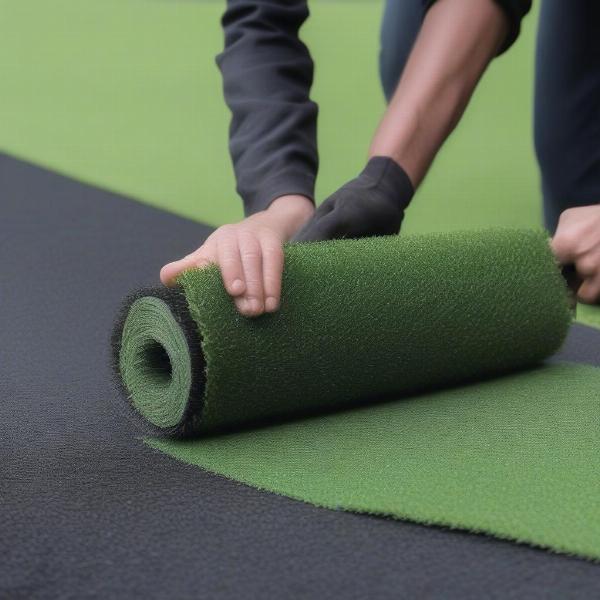Synthetic turf has become increasingly popular for dog owners looking for a low-maintenance, aesthetically pleasing alternative to natural grass. But with so many options on the market, choosing the right synthetic turf for your furry friend can feel overwhelming. This guide will walk you through everything you need to know about synthetic turf for dogs, from its benefits and drawbacks to installation and maintenance.
Benefits of Synthetic Turf for Dogs
Synthetic turf offers several advantages for dog owners:
- Durability: Unlike natural grass, which can become patchy and muddy with heavy use, synthetic turf can withstand the wear and tear of playful paws. It’s designed to resist digging, scratching, and even the occasional potty accident.
- Low Maintenance: Say goodbye to mowing, watering, and fertilizing! Synthetic turf requires minimal upkeep, freeing up your time and saving you money on landscaping costs.
- Cleanliness: Synthetic turf is highly permeable, allowing urine to drain through quickly. Solid waste can be easily scooped up and the area rinsed clean, minimizing odors and promoting a hygienic environment.
- Pest Control: Synthetic turf is less susceptible to pests like fleas and ticks, reducing the risk of infestations and keeping your dog healthy.
- Year-Round Green: Maintain a lush, green lawn all year round, regardless of the weather. No more brown spots or muddy patches, just a consistently beautiful outdoor space for your dog to enjoy.
Choosing the Right Synthetic Turf
Not all synthetic turf is created equal. When selecting turf for your dog, consider these factors:
- Pile Height and Density: Opt for a shorter pile height and denser thatch to prevent matting and provide a more comfortable surface for your dog to play on.
- Drainage: Excellent drainage is crucial to prevent odor buildup and ensure the turf stays clean and hygienic. Look for turf with a permeable backing and efficient drainage holes.
- Infill: Infill materials like silica sand or crumb rubber help to weigh down the turf, provide cushioning, and improve drainage. Consider antimicrobial infill options to further enhance hygiene.
- Durability: Choose a turf specifically designed for pets, as it will be more resilient to wear and tear. Look for high-quality materials and construction.
Installing Synthetic Turf for Dogs
Proper installation is essential for the longevity and performance of your synthetic turf. While professional installation is recommended, DIY installation is possible with careful planning and execution.
- Prepare the Area: Remove existing grass and level the ground. Install a weed barrier to prevent weeds from growing through the turf.
- Lay the Turf: Carefully roll out the turf and secure the edges. Trim any excess turf with a sharp utility knife.
- Apply Infill: Spread the infill material evenly over the turf and brush it in using a power broom. Repeat this process until the desired infill level is achieved.
 Installing Synthetic Turf for Dogs
Installing Synthetic Turf for Dogs
Maintaining Synthetic Turf for Dogs
Maintaining your synthetic turf is easy:
- Regular Brushing: Brush the turf regularly to remove debris and prevent matting.
- Rinsing: Rinse the area with water to flush away urine and other contaminants.
- Spot Cleaning: Clean up solid waste promptly and rinse the area with a mild detergent if necessary.
- Professional Cleaning: Consider professional deep cleaning once or twice a year to remove any deep-seated dirt and odors.
Will Dogs Pee on Artificial Grass?
Yes, dogs will pee on artificial grass just as they would on natural grass. The porous nature of the synthetic turf allows urine to drain through, preventing pooling and minimizing odor.
Conclusion
Synthetic turf provides a practical and attractive alternative to natural grass for dog owners. Its durability, low maintenance, and cleanliness make it an ideal choice for creating a safe and enjoyable outdoor space for your furry friend. By carefully selecting and maintaining the right type of synthetic turf, you can provide your dog with a comfortable, hygienic, and aesthetically pleasing environment for years to come.
FAQ
- Is synthetic turf safe for dogs? Yes, high-quality synthetic turf designed for pets is safe for dogs.
- How do you clean dog poop off artificial turf? Simply scoop up the solid waste and rinse the area with water.
- Does synthetic turf get hot in the sun? Yes, it can get hot, but choosing a lighter color turf can help mitigate this.
- How long does synthetic turf last? With proper care, synthetic turf can last for 10-15 years or more.
- Can I install synthetic turf myself? While professional installation is recommended, DIY installation is possible.
- What is the best infill for dog turf? Antimicrobial infill options are recommended for enhanced hygiene.
- How often should I brush my synthetic turf? Brushing once or twice a week is generally sufficient.
Related Articles
- best synthetic turf for dogs
- how to prevent dogs from pooping on your lawn
- will dogs pee on artificial grass
- turf cleaner for dogs
ILM Dog is your trusted resource for expert dog care advice, offering guidance on breed selection, health and medical care, training, nutrition, grooming, and much more. From puppy care to senior dog care, we cover every aspect of dog ownership. For expert advice tailored to your dog’s unique needs, contact us at [email protected] or +44 20-3965-8624. Visit ILM Dog for comprehensive resources and expert advice on all things dog-related.